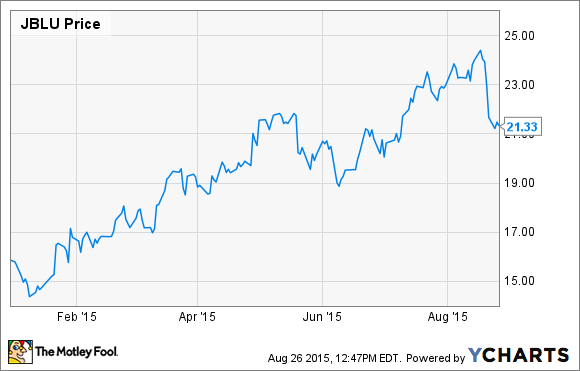Fears about a looming economic slowdown in China and the potential impact of higher interest rates in the U.S. have caused turmoil in the stock market this month. This has a left a lot of stocks looking cheap.

The recent stock market sell-off has airline stocks looking cheap. Photo: American Airlines.
That's especially true in the airline sector, where valuations were very low even before August. Furthermore, the current economic worries have caused a steep drop in oil prices, which should help airlines. With that in mind, here are three airline stocks that look especially appealing now: American Airlines (AAL +0.19%), Virgin America (VA +0.00%), and JetBlue Airways (JBLU 5.88%).
A global giant -- not so giant in Asia
American Airlines stock peaked at $56.20 earlier this year, but it has since lost about a third of its value, including a double-digit plunge just since mid-August.
American Airlines YTD Stock Performance, data by YCharts
Yet the stock looks very attractive for several reasons. First, it has a bargain-basement valuation. It currently trades for a little more than four times American's projected 2015 earnings. This figure is a bit deceptive, because American Airlines isn't accruing taxes this year due to previous losses. However, even including a normal tax rate, the stock would trade for about seven times earnings.
Second, American Airlines does not hedge its fuel costs, so it will quickly reap the full benefit of the recent drop in oil prices. That will help offset any further unit revenue weakness it may face.
Finally, American Airlines isn't exposed much to China -- or Asia more broadly. The carrier has just five daily flights to mainland China, plus one to Hong Kong. Two-thirds of its capacity is deployed in the U.S., while its international routes are focused on Europe and Latin America. Those regions have their own problems, but they aren't any worse today than they were a month ago.
An underappreciated trendsetter
While American Airlines isn't as exposed to Asia as its legacy carrier rivals, Virgin America doesn't fly there at all. In fact, its only international routes are a few flights to popular Mexican resort areas.
Nevertheless, Virgin America shares have been caught up in the global stock sell-off. The stock had rallied briefly after Virgin America produced a great Q2 earnings report and solid guidance for the rest of the year and 2016. However, the stock has now given back most of those gains, and is down nearly 30% year to date.
Virgin America YTD Stock Performance, data by YCharts.
Yet Virgin America has been one of the top performers in the industry in terms of unit revenue this year. While it has projected a unit revenue decline for Q3, it has several positive catalysts that should improve its unit revenue trajectory thereafter. Meanwhile, it expects non-fuel unit costs to decline slightly in 2016, while its average fuel cost per gallon is on track to decrease significantly next year.
Despite these tailwinds that could drive profit growth next year and beyond, Virgin America stock now trades for less than seven times its projected 2015 EPS. At that price, it looks like a great bargain.
A fast-rising coastal powerhouse
Finally, JetBlue Airways has been the best-performing U.S. airline stock this year, but even it has not been immune to the stock market's recent plunge. In fact, the stock has declined by more than 10% from the multiyear high it hit just last week.
JetBlue YTD Stock Performance, data by YCharts.
JetBlue stock trades for nearly 12 times projected 2015 earnings, so it's not as cheap as the other airline stocks highlighted here. However, it looks just as undervalued due to JetBlue's stellar 2015 performance and strong long-term growth prospects.
Like Virgin America, JetBlue has no exposure to China or most of the other weak economies of the world. Its biggest domestic markets -- New York, Boston, and Florida -- have also been relatively insulated from the fare wars that have broken out in parts of the U.S. airline industry. As a result, it is the only U.S. carrier poised to post unit revenue growth for the full year.

The expansion of its Mint premium service is just one key profit-growth driver for JetBlue. Photo: JetBlue Airways.
JetBlue has a fairly modest hedge book, so it will see plenty of savings if oil prices remain low. Additionally, the company recently implemented a new fare structure that is expected to produce $200 million in annual benefits by 2016 or 2017.
Other profit-growth drivers are also in the works. JetBlue will expand its popular Mint premium service during the next year, it will benefit from a new credit card partnership starting in 2016, and it will add 15 seats to each of its A320 aircraft during the next few years to reduce unit costs. These initiatives will add hundreds of millions of dollars to JetBlue's bottom line.
Despite all of these profit-growth drivers, JetBlue stock is trading at a steep discount to the broader market. That practically makes it a steal at its recent trading price below $22.
There's no such thing as a sure thing in the stock market. But shares of American Airlines, Virgin America, and JetBlue have all fallen to a point where the upside seems to far outweigh the risk. The benefit of lower fuel costs should offset any incremental demand weakness for all three airlines, driving profit growth -- and in all likelihood, rebounding share prices.









